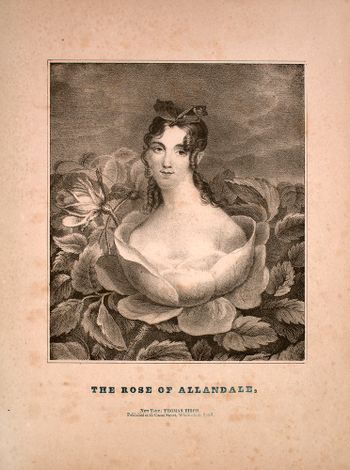Annotation:Rose of Allandale (The): Difference between revisions
No edit summary |
No edit summary |
||
| (6 intermediate revisions by 2 users not shown) | |||
| Line 1: | Line 1: | ||
---------- | |||
{{TuneAnnotation | |||
|f_tune_annotation_title= https://tunearch.org/wiki/Annotation:Rose_of_Allandale_(The) > | |||
|f_annotation='''ROSE OF ALLENDALE, THE.''' English, Air (whole time). C Major (Howe/Accordeon): D Major (Howe/Companion, Sumner/Gibbons). Standard tuning (fiddle). AABB. The provenance of the song "Rose of Allendale" [Roud 1218] is sometimes credited to Ireland or Scotland, but the air and song is associated with north of England where Allendale is a town in Northumberland, north-east England. Rather than a traditional piece, it is a composed parlor song by Charles Jeffreys, set to music by Sidney Nelson in the first half of the 19th century. Dating the piece is uncertain: it was printed in England in '''Blake's Young Flutist's Magazine''' in 1833, and was included in New York music publisher Edward Riley's '''Flute Melodies, vol. 4''', dated 1826. The first stanza and chorus (in the Copper Family's version) go:[[File:allendale.jpg|350px|thumb|right|]] | |||
---- | |||
---- | |||
'''ROSE OF ALLENDALE, THE.''' English, Air (whole time). C Major (Howe/Accordeon): D Major (Howe/Companion, Sumner/Gibbons). Standard tuning (fiddle). AABB. The provenance is sometimes credited to Ireland or Scotland, but the air and song is associated with north of England where Allendale is a town in Northumberland, north-east England. Rather than a traditional piece, it is a composed parlor song by Charles Jeffreys, set to music by Sidney Nelson in the first half of the 19th century. The first stanza and chorus go: | |||
<blockquote> | <blockquote> | ||
''The morn was fair, the sky was clear, no breath came over the sea,''<br> | ''The morn was fair, the sky was clear, no breath came over the sea,''<br> | ||
| Line 22: | Line 14: | ||
</blockquote> | </blockquote> | ||
There is sometimes confusion of titles with J. Scott Skinner's “[[Rose Bud of Allenvale (The)]].” | There is sometimes confusion of titles with J. Scott Skinner's “[[Rose Bud of Allenvale (The)]].” | ||
|f_source_for_notated_version=the 1823-26 music mss of papermaker and musician Joshua Gibbons (1778-1871, of Tealby, near Market Rasen, Lincolnshire Wolds) [Sumner]. | |||
|f_printed_sources=Howe ('''Complete Preceptor for the Accordeon'''), 1843; p. 14. Howe ('''Second Part of the Musician's Companion'''), 1843; p. 4. Edward Riley ('''Riley's Flute Melodies, vol. 4'''), 1826; p. 94. Sumner ('''Lincolnshire Collections, vol. 1: The Joshua Gibbons Manuscript'''), 1997; p. 25. | |||
|f_recorded_sources=Dara Records DARA, Mary Black - "Rose of Allendale" (1982). | |||
|f_see_also_listing=Jane Keefer's Folk Music Index; An Index to Recorded Sources [http://www.ibiblio.org/keefer/r09.htm#Rosofal]<br> | |||
Hear a version of the song by Andy Turner [https://afolksongaweek.wordpress.com/2014/07/25/week-153-rose-of-allendale/]<br> | |||
}} | |||
------------- | |||
<br> | |||
---- | |||
< | |||
Latest revision as of 05:30, 19 February 2021
X:1 T:Rose of Allandale, The M:C L:1/8 R:Air B:Elias Howe – Second Part of the Musician’s Companion (1843, p. 4) Z:AK/Fiddler’s Companion K:D V:1 d>e|f3e d3c|edcB A3A|A3d d2 ef|d4 z2 d>e| f3 e d3c|edcB A3A|B d3 cdef|d6 d2:| |:e3c A3A|f3d A3f|g2fe f3d|e6 de| f3e d3c|edcB A3A|B3 d cdef|d6 z2:| V:2 z2|d3c B3A|cBAG F3F|F3A A2 cd|A4 z2 A>c| d3c B3A|cBAG F3F|G B3 ABcd|F6 F2:| |:c3A F3F|d3B F3d|e2 dc d3A|c6 Ac| d3c B3A|cBAG F3F|G3B ABcd|F6 z2:| V: 3 clef=bass middle=d z2 |d2z2 d2z2 | A2z2 A2z2 | A2z2 d2z2 | d4 z2z2 | d2z2 d2z2 | A2z2 A2z2 | G2z2 A2z2 | d6 d2 :| |:A2z2 A2z2 | d2z2 A2z2 | G2z2 d2z2 |A6 z2 | d2z2 B2z2 | A4 A3A | G2z2 A2z2 | d6 z2 :|

The morn was fair, the sky was clear, no breath came over the sea,
When Mary left her highland cot and wandered forth with me.
Though flowers decked the mountain side and fragrance filled the vale,
By far the sweetest flower there was the Rose of Allendale.
Chorus:
Sweet Rose of Allendale, sweet Rose of Allendale,
By far the sweetest flower there was the Rose of Allendale.
There is sometimes confusion of titles with J. Scott Skinner's “Rose Bud of Allenvale (The).”

